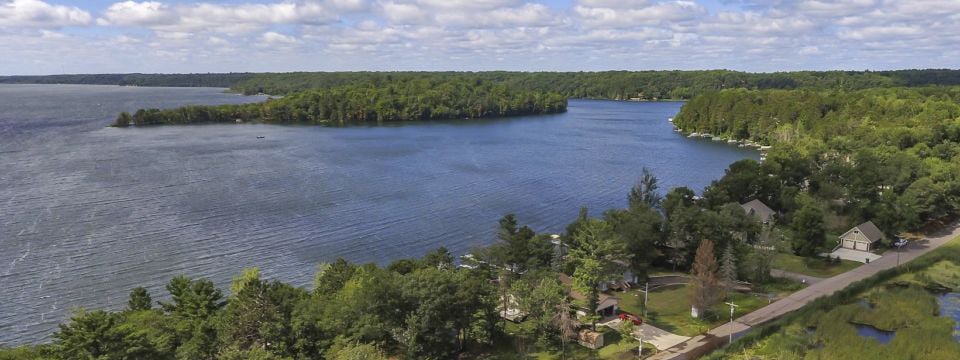Water, Water Everywhere, and Too Much in My Lake

In a typical weather pattern, many lakes will be “full” after the spring snowmelt and rains arrive; then the water level will slowly drop as summer progresses. The Minnesota DNR tracks the levels of many lakes with electronic equipment and the help of volunteers who read lake level gauges throughout the summer.
Some lakes are landlocked, meaning they have no natural outlet. If we have a number of wet years, the water level can rise significantly in such lakes, and the results may not be pleasant.
Shoreline Erosion
High water encroaches onto property, waterlogs landscaping, and the resulting wave action can result in a loss of beach, plantings, trees, and other landscaping. More severe erosion can even eat away at shoreline, resulting in a loss of physical property.
Biotic Impacts
Extended periods of submergence (i.e., water covering areas that are normally above the water line) can cause a loss of native vegetation and wildlife habitat. Underground wildlife passageways may become flooded, blocking the animals’ movements or harming them.
Infrastructure Damage
In addition to shoreline erosion, standing water can overtop docks and flood boathouses, garages, and cabins, creating a range of damage.
Flooded Septic Systems
Of significant concern is when high water inundates and damages lakeside septic systems. A health threat is created when bacteria leaks from the system and becomes present in the nearby water, sickening those who come in contact with it. Further, the nutrients once confined in the septic system are now available to algae, potentially triggering a localized algal bloom.
High lake water levels are not new. They’ve occurred around the state for many years, and I’ve experienced and researched a variety of solutions. Here are some alternatives that range from practical but temporary to more involved (and costlier) yet more permanent:
Sandbagging
While this measure won’t stop water from coming onto lakeshore property, it will cut down on wave action and shoreline erosion. Unfortunately, to prevent water from encroaching on property, long stretches of shoreline need to be sandbagged and watertight. Building sandbag dikes around homes could provide temporary relief, but this is not a feasible option for extended periods of time.
Moving Structures
Adjustable docks can be raised, and some structures can be moved such as outdoor furniture or a small bathhouse, but larger structures may be too big and cumbersome. Sandbagging might buy some time but isn’t a long-term solution.
Constructed Outlet
In some circumstances, constructing an outlet from the lake to drain the excess water is a viable long-term solution. An investigation would determine if this option is feasible as well as to determine to what waterbody the water could drain.
Pumping
This option is rather a last resort and involves operating a very large water pump over several weeks to months. The water is pumped and discharged outside of the lake’s water basin, ensuring the groundwater doesn’t simply return to the lake. This is a serious undertaking that involves determining to where the water can be pumped safely as well as possible impacts such pumping will have on the surrounding area. This option is expensive, but grant funding sources may be available to defray some of the costs.
The constructed outlet and pumping options require permits, permissions, environmental investigations, and considerable coordination with several government agencies. These options are best pursued with the help of professionals who are knowledgeable of the lake, surrounding area, and the agencies that would be involved.

Search Archives
Categories
Posts by Topic
- Staff News (98)
- Architecture (66)
- Funding (61)
- Civil Engineering (53)
- Education (48)
- Architectural Design (38)
- Engineering (37)
- Land Surveying (32)
- Surveying (26)
- Environmental (22)
- Commercial (21)
- Interior Design (18)
- Streets & Highways (17)
- Utilities (17)
- Water Resources Engineering (14)
- Industrial (13)
- Community (11)
- Cultural (11)
- Landscape Architecture (11)
- Sports & Recreation (11)
- Government (10)
- Aerial Mapping (8)
- Mechanical Engineering (8)
- GIS (7)
- Electrical Engineering (6)
- Structural Engineering (6)
- Senior Living (5)
- Transportation Engineering (5)
- Bridges (3)
- Site Design (3)
- Transmission & Distribution (3)
- Healthcare (2)
- Planning (2)
- manufacturing (1)
Recent Posts
-
May 06, 2024



